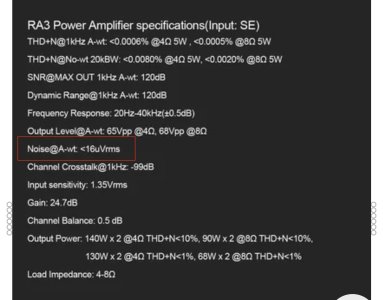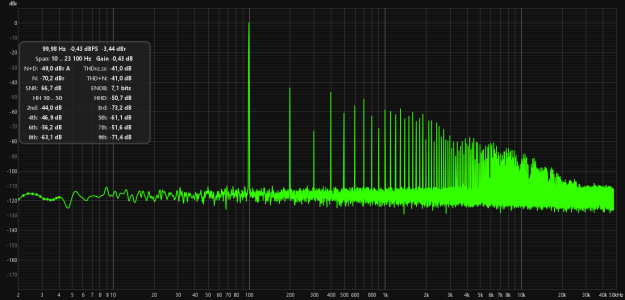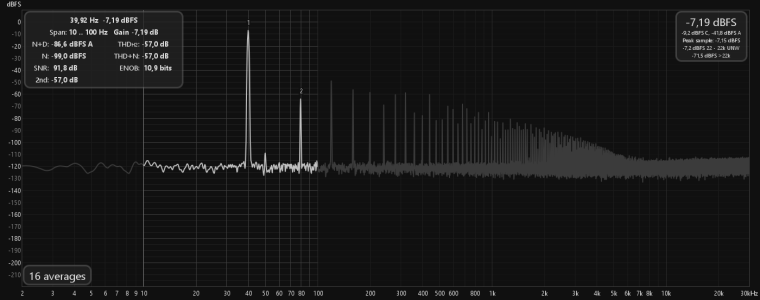What exactly do you mean by that? Noise level on the speaker output when nothing is played?Is it possible to measure residual noise?
You are using an out of date browser. It may not display this or other websites correctly.
You should upgrade or use an alternative browser.
You should upgrade or use an alternative browser.
My WiiM Amp tests
- Thread starter onlyoneme
- Start date
crosstalk vs frequency...(at 1w or 5w..)
I regret having written that... as it stands, don't waste your time on these measures and more importantly, don't take any risks by raising the levelsVs frequency or vs level? Stepped sine with one channel driven but second one captured?
It's around 125-135 uV unweighted in 10-22400 Hz span, when output is not muted - for example when digital input is active or very low level signal (aka "silence") is played. It's less for idle mode when HiFi/Ethernet input is use, but I do not remember the exact value.I don't understand proper English.
This is my TPA3255 amp and AVR spec sheet. I think it's noise when it's silent.
View attachment 3963
View attachment 3964
Thank you!It's around 125-135 uV unweighted in 10-22400 Hz span, when output is not muted - for example when digital input is active or very low level signal (aka "silence") is played. It's less for idle mode when HiFi/Ethernet input is use, but I do not remember the exact value.
I believe you are thinking "4 ohm droops, 8 ohm peaks, 6 ohm should therefore be pretty flat": yes, with a resistor. But speakers never have a flat impedance, and generally it rises at high frequencies, where the output impedance of this thing (per the graph in the 1st post) is rising. Which surprising myself makes me conclude...maybe it's not such an awful problem? Though if would be nice if they implemented the Post-Filter FeedBack.Regarding load dependence, is there an issue when impedance of the loudspeaker is 6 Ohms? The KEF LS50 Meta has a 6 Ohm impedance at higher frequencies.
We have to keep some perspective, this thing sells at $299 with all the streaming and connections like AirPlay and a subwoofer out (WITH highpass OMG alleluia!!!) and HDMI ARC and it's really small and the measurements are not SOTA but at least good I'd say and and and.
- That's a serious question...even for somewhat more money IS there a better amp?* Even for more more money is there a better compact amp? (By compact I mean I dunno, half width half height, to mount on a wall hidden behind my TV?
Any reason I couldn't mount WiiM Amp on the wall, hidden behind my TV? Remote is RF or IR?
Currently out of stock, probably awaiting some hardware and software changes? This is reminding me of Apple and Tesla, the new method, get it out their to the eager Beta newbies then recalibrate and fix.
*maybe this, but not compact https://www.monoprice.com/product?p_id=43866
Brantome
Major Contributor
- Joined
- Oct 20, 2022
- Messages
- 6,842
Remote is RF or IR?
Bluetooth
Or less pessimistically or less cynically, they’re doing what many also do in having a limited first production run to gauge the market’s appetite for the device then ramp up subsequent productions runs to meet demand, almost mirroring what they did a year ago with the Pro?Currently out of stock, probably awaiting some hardware and software changes? This is reminding me of Apple and Tesla, the new method, get it out their to the eager Beta newbies then recalibrate and fix.
Nah, ya gotta retest the fixed version! Meanwhile thanks SO SO SO much for actual MEASUREMENTS in a review. That is a godsend.Or maybe that's all, folks
Mmmm would you hook this up to a high sensitiviy horn speaker? With speakers you have can you hear any hiss?
jeromeof
Member
So if the subwoofer has LPF set to anything less than say 120hz would this be a problem in reality?As I got yet another interface - UCX II, quick test to verify if something has changed in terms of sub out performance. No, no change
View attachment 4132
And it seems to be fixed indeed, looks like no drifting.Latest FW promises fixes for clock drifting when toslink input is used. I didn't mention it but I've seen it reported by REW.
Steve Woodhouse
Major Contributor
- Joined
- Aug 11, 2023
- Messages
- 1,986
A signal sent to the SW from the Amp has quite high amount of harmonic distortions. Higher level harmonics can be filtered out by the LPF of SW, but usually at least 2nd one will remain
View attachment 4135
To confirm, if the sub set to 80hz that’s good, if it’s set to anything less than 75, there shouldn’t be an issue, is that right?
If so, what if you set the WiiM’s crossover to 75?
As I got yet another interface - UCX II, quick test to verify if something has changed in terms of sub out performance. No, no change
View attachment 4132
Then for example the 3rd harmonic of 25 Hz and the 2nd of 37.5 Hz will be still in the range easily.If so, what if you set the WiiM’s crossover to 75?
If I lower the subwoofer volume level on my WiiM amp and increase the volume of the subwoofer, will it have less effect?Then for example the 3rd harmonic of 25 Hz and the 2nd of 37.5 Hz will be still in the range easily.
(Of course, I hope the WiiM team solves this problem.)
You can see that hereIf I lower the subwoofer volume level on my WiiM amp and increase the volume of the subwoofer, will it have less effect?
(Of course, I hope the WiiM team solves this problem.)
Distortions are fine up to -15 dBFS, then it starts to grow rapidly.
Thank youYou can see that here
Distortions are fine up to -15 dBFS, then it starts to grow rapidly.
Similar threads
- Replies
- 36
- Views
- 832
- Replies
- 7
- Views
- 1K
- Replies
- 83
- Views
- 2K
- Question
- Replies
- 13
- Views
- 2K
- Replies
- 4
- Views
- 987




